The anti-lock braking system (ABS) consists of wheel speed sensors, a brake pedal switch, a gyro-electronic control module and warning lights in the instrument cluster
It includes a brake force distribution (EBD) system and a self-diagnostic system that detects malfunctions of system components.
ABS is used to regulate the pressure in the brake mechanisms of all wheels when braking in difficult road conditions and thereby prevents the wheels from locking.
The ABS system provides the following benefits:
- - obstacle avoidance with a higher degree of safety, including during emergency braking;
- - reduction of the braking distance during emergency braking while maintaining roadholding and controllability of the car, including when turning.
In the event of a system failure, diagnostics and maintenance functions are provided in case of system failures.
The hydroelectronic control module receives information about the vehicle speed, direction of travel and road conditions from the wheel speed sensors and the throttle position sensor.
After the ignition is switched on, the control unit supplies voltage to the wheel speed sensors, which use the Hall effect.
The sensors generate an output signal in the form of pulses.
The signal changes in proportion to the frequency of rotation of the encoder's pulse ring.
Based on this information, the control unit determines the optimal wheel braking mode.
The following modes of operation of the anti-lock braking system are distinguished:
- normal braking mode
During normal braking, the intake valve is open, the exhaust valve is closed.
When you press the brake pedal, brake fluid under pressure is supplied to the working cylinder and actuates the wheel brakes.
When the brake pedal is released, the brake fluid returns to the brake master cylinder through the intake and check valves;
- emergency braking mode
If the wheel locks up during emergency braking, the module issues a command to the pump motor to reduce the supply of brake fluid, then voltage is applied to each solenoid valve.
The intake valve closes and the brake fluid supply from the master cylinder and pump is shut off; the exhaust valve opens, and the brake fluid flows from the working cylinder to the master cylinder, and then to the reservoir, which causes a decrease in pressure;
- pressure maintenance mode
When the pressure in the working cylinder is reduced to the maximum, the module issues a command to maintain the brake fluid pressure, voltage is applied to the intake valve and not applied to the exhaust valve.
At the same time, the inlet and outlet valves are closed, and the brake fluid does not leave the working cylinder;
- pressurization mode
If the module determines that the wheel is not blocked, then the voltage is not applied to the solenoid valves, the brake fluid through the inlet valve enters the working cylinder, the pressure in which increases.
To diagnose and repair the anti-lock brake system, special equipment and equipment are required, therefore, in case of failure, contact a specialized service station.
This only describes the replacement of the wheel speed sensors and the hydro-electronic module.
However, please note that special equipment is required to remove air that can get into the valve system of the hydro-electronic module during unskilled removal.
This is why we do not recommend removing the module unless absolutely necessary.
Removing the ABS unit
We install the car on a viewing ditch or lift
We mark the location of the tubes suitable for the hydraulic unit

In the engine compartment on the right side with an open-end wrench for 11 or a special wrench for fittings of brake pipes, unscrew the fittings of six brake pipes and disconnect the pipes from the hydraulic unit.
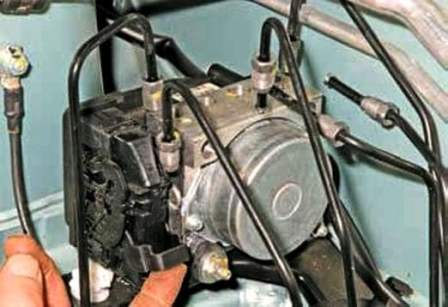
Prying up the wire harness retainer
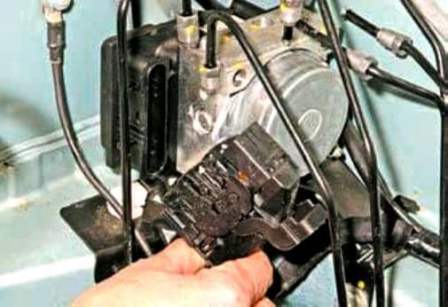
Disconnect the block from the control unit
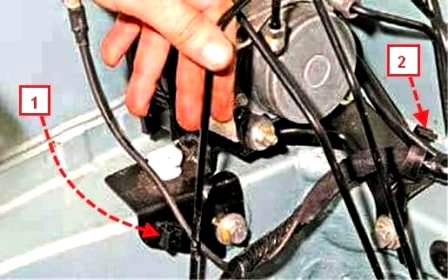
We remove the brake pipe from the holder 1 and the wiring harness from the holder 2 of the ABS unit bracket
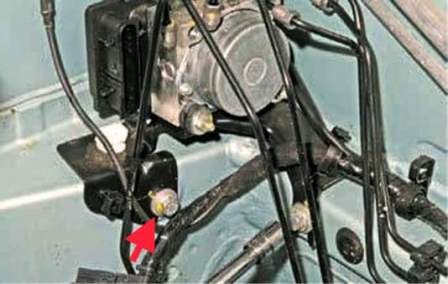
With a 13 head, we unscrew the two bolts securing the ABS unit bracket to the body and remove the ABS unit with the bracket.
The ABS unit is attached to the bracket through two rubber bushings.
If the bushings are cracked or the rubber has lost its elasticity, we replace the bushings.

Having unscrewed the two nuts securing the ABS block to the bracket with a 10 wrench, we separate the block and the bracket.
Install the ABS unit in reverse order.
Bleeding the hydraulic brake drive system (article - Replacing and bleeding the hydraulic brake and clutch Renault Duster) .
Removing the front wheel speed sensor
Raise the front of the car
Remove the front wheel liner
Securely fix the car on the stand
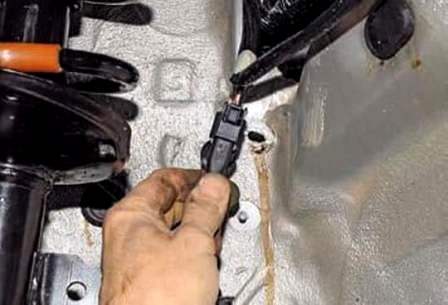
Remove the holder of the wiring harness block from the hole in the mudguard of the body
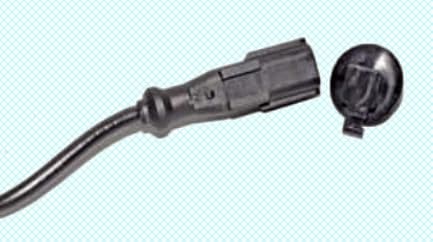
Sensor harness block with holder removed
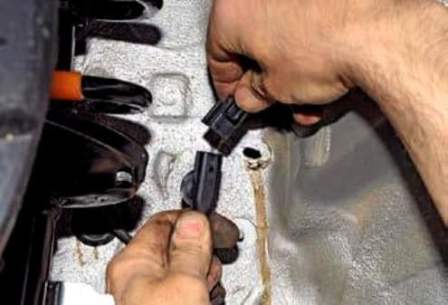
Press the latch and disconnect the front wiring harness block from the sensor wiring block

We remove the rubber sleeve of the sensor wiring harness from the plastic holder located on the mudguard

And two more couplings - from the bracket located on the shock strut
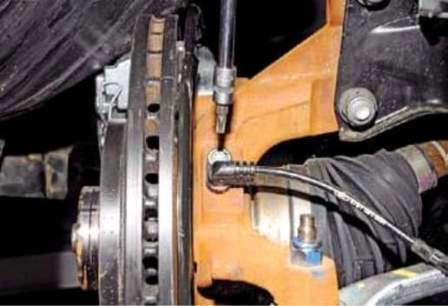
Using the TorxT-30 key, unscrew the screw securing the sensor to the steering knuckle

Remove the wheel speed sensor from the steering knuckle
Before installation, we clean the installation site of the sensor, as well as the sensor itself.
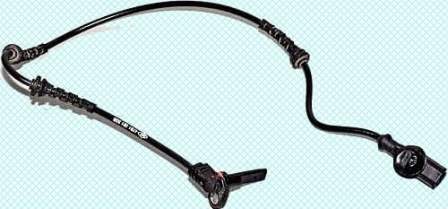
Install the sensor in reverse order
Removing the rear wheel speed sensor
Hang out the back of the car and remove the wheel.
Fix the car on a stand.
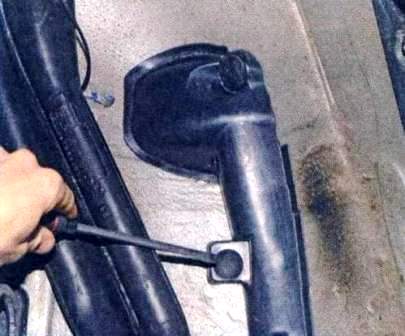
Using a flat screwdriver, unscrew the two plastic nuts securing the protective cover of the sensor wiring harness.
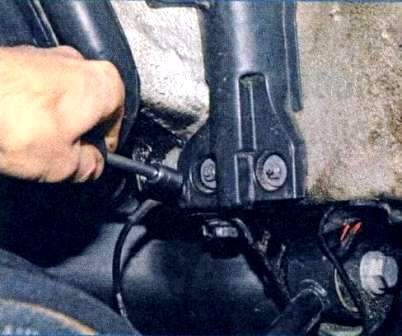
With a 10 head, unscrew the two nuts securing the casing

Remove the casing from the arch and remove the wiring harnesses from the casing holders
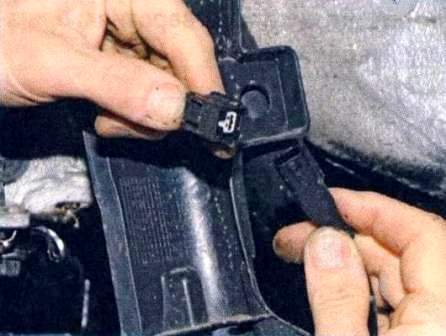
Pressing the latch, disconnect the rear wiring harness block from the sensor wiring harness block

Remove the rubber sleeve of the sensor wiring harness from the holder on the rear suspension arm.
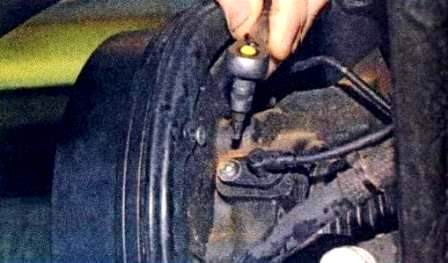
Use the TorxT-30 key to unscrew the sensor mounting screw
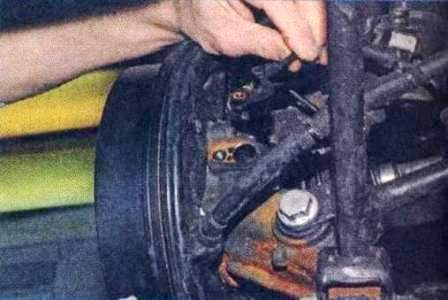
Remove the sensor from the fist hole
Install the sensor in reverse order.




